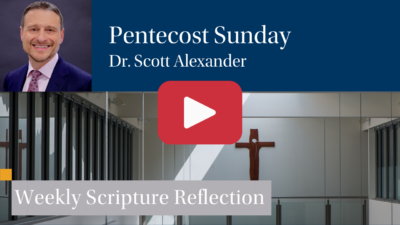
Readings:
Reading I: Acts 2:1-11
Psalm: 104:1, 24, 29-30, 31, 34
Reading II: 1 Cor 12:3b-7, 12-13
Gospel: Jn 20:19-23
As any survivor of a tornado or forest fire will tell you, There is something powerful, even terrifying, about wind and fire.
The terrifying qualities of wind and fire were surely at the forefront of the minds of the many biblical authors who recount stories of wind and fire as signs accompanying the awesome presence of the divine in the natural world (e.g., Ex 3:2, 13:21-22, 19:18).
The story-teller of Luke-Acts seems to be well aware of the biblical tropes of wind and fire as terrifying portents of the divine presence. But like the ancient Israelite authors, this New Testament writer knew that wind and fire are anything but one-dimensional images and symbols.
Like so many of us, the author of today’s First Reading must have experienced wind and fire in far less violent, yet equally intense ways: The cool, refreshing gusts that come with the thunderstorm that finally breaks an oppressive heatwave. The domestic fires which, for millennia, have been the focal points for familial and communal gatherings and celebrations: for cooking, eating, story-telling, dancing and singing. These are just a few of the blessed, some might even say sacramental, roles that wind and fire play in our lives.
Among the many benevolent expressions of wind and fire in nature, however, there are at least two that are frequently overlooked—most likely because they happen inside of us rather than in the world “out there.” I’m referring here to the role of wind as breath and fire as the metabolic energy production that occurs within our own bodies and the bodies of almost every other creature on the planet.
Pulmonologist and biomedical researcher Dr. Michael J. Stephen opens his recent book about the biological wonder that is the human lung (Breath Taking: The Power, Fragility, and Future of Our Extraordinary Lungs), with a reflection on the Hebrew word for both “breath” and “spirit of life”—ruach—complete with references to Genesis 2:7 as well as, if you can believe it, today’s Gospel passage from John chapter 20.
Dr. Stephen does this to underscore an almost clichéd but nonetheless profound truth affirmed by scientists and theologians alike: “Life and breath are synonymous” (8).
This may sound like little more than a platitude. Stephen realizes this, and makes it one of the principal aims of the book to argue that the “life = breath” equation is anything but. He insists that we recognize the profound connections between the spiritual and the empirical dimensions of this equation by looking at a key set of facts:
The fact, for example, that “every organ above the level of microscopic anaerobe respires, including every single fish and animal, as well as plants.”
The fact that, although each day a pair of human lungs does the heavy lifting of processing roughly 10,080 liters of air—those of us who are fortunate enough not to suffer from any kind of lung disease hardly even notice. (This sounds a lot to me like the work of the Holy Spirit—most of the work of sustaining life without a whole lot of recognition!)
The fact that, above all other organs, it is our lungs that function as the threshold connecting us to the world beyond the physical parameters of our bodies.
Think about this. Stephen is asking us to consider that respiration is the principle and foundational activity by which we commune with other human beings and all other living creatures. As individual organisms we join with all other life forms and the rest of the natural world in the symphonic inhalation and exhalation of what Stephens refers to as “this communal resource called the atmosphere.”
And finally, there is the fact that the linchpin for understanding how lungs and breathing became the evolutionary cornerstone of all life is the combustion—the fire—that occurs when, through the winds of respiration, oxygen becomes energy for each and every cell of each and every living being.
Stephen’s reflections imply that the wind of breath and the fire it catalyzes within all living beings together comprise a more powerful natural force than any tornado or conflagration—a force that is anything but terrifying. Instead, the “winds” and “fires” associated with breathing are life-giving and life-sustaining. They can even be, as Stephens goes on to argue in his later chapters, healing and restorative.
As the words of the Sequence sing: “Heal our wounds, our strength renew; On our dryness pour your dew!” What better way to understand the mutually illuminating messages of all three of today’s readings and the Pentecostal Sequence?
Recall how the first reading from the Acts of the Apostles speaks to us of the gift of the Holy Spirit mediated by “a noise like a strong driving wind” (in the original Greek: φερομένης πνοῆς βίαιας). The adjective the author uses to describe the wind—translated in the lectionary as “driving”—is extremely important. The Greek word is pheroménēs and comes from a root meaning to carry. By choosing this word, the author is signaling to us the purpose of this literally “violent wind.”
If the zephyr could speak, it is as if it would say to the apostles: “Ok. It’s terrific that you are gathered together in one room ‘in one accord.’ I understand how tempting it is to bask in the glow of this new experience of unbroken solidarity—especially given what a relatively contentious group you’ve been up until this point…BUT NOW IT’S TIME TO GET MOVING!!”
Like the inhalation that brings combustible oxygen to every single cell in the body, the strong wind catalyzes “tongues of fire”—a combustion of missionary zeal that, as it first ignites, expresses itself as the ability to communicate the Good News in and through the stunning diversity of languages and cultures that mark different branches of the human family.
Placed in conversation with the imagery of the second reading from 1 Corinthians 12, whereby the one Spirit is portrayed as animating the many diverse parts of the body, I am reminded of another passage from Stephen’s book. After describing the tree-like structure of the trachea as a “trunk” that “branches into the bronchi of the right and left lungs” and finally “into grapelike clusters called alveoli,” Stephen reminds us that,
“Other examples of this configuration in nature abound—streaks of lightning converging into a single bolt only to diverge again as they approach the ground; the tributaries of a riverbed unifying into one main waterway; the human body itself, branching from its trunk to arms and legs, then fingers and toes” (10).
Could the parallel between the reflections of our 1st-century evangelist and those of our 21st-century pulmonologist be more striking?
Interpreted through the lens of Stephen’s work, I cannot help but see the two readings from Acts and 1 Corinthians as an invitation to imagine the apostles—and all those baptized into the same mission—as the lungs of the present and future body of Christ. As the lungs of the Risen Christ, we are called to commune with every other creature and the whole natural order by breathing in our portion of the atmosphere that belongs to all and helping to deliver the oxygen of the Word back to every diverse part of the cosmos which sustains us as we are commissioned to sustain it.
Finally, there is today’s Gospel from John 20 and the way in which, at least for me, it grounds the jointly constructed wind and fire metaphor of the first two readings in the literal reality of Jesus’s resurrected body of flesh and bone. Evoking the image of Genesis 2:7, the Crucified and Risen One shares his peace through his breath so that, as God breathed the animating breath of physical vitality into the nostrils of Adam, Jesus breaths onto his disciples the breath of the Good News of life everlasting in his redemptive love.
But like the missionary combustion of the tongues of fire ignited by the “driving wind,” this breath and the metabolic fire it catalyzes is not to be coveted as some kind of a personal gift to be shared only among an elite few. Jesus’s message to those upon whom he breathes is clear:
‘My breath is for you, but not only for you. The Spirit is for you, but not only for you. For as the Father sent me to share my life-giving and healing love with those with whom I have shared earthly life in atmospheric communion, you—as my disciples—are called and sent by the Spirit and in the Spirit to share God’s life-giving and healing love with all creation.’
Another important lesson that emerges when we read this Gospel in light of the science of pulmonology is that, like the physiological act of breathing, the sharing of God’s Word and love must be mutual and not uni-directional. We share it not only by the exhalation of giving, but also by the inhalation of receiving this same love in deep and abiding atmospheric communion with all our fellow human beings and all living creatures.
For this reason, we must never lose sight of the connection between Christian mission and care of creation.
Educated and edified by the wondrous discoveries of science, the reading’s for the Solemnity of Pentecost offer us a simple but powerful message: As missionary disciples of Christ, we must never cease to engage and reengage in the primal atmospheric communion of inhaling and exhaling God’s Word together with all creatures “great and small.” As followers of the crucified and risen One, we must never forget to breathe deeply and fully as we commit ourselves to lives of profound reverence and care for one another—especially the marginalized and oppressed—as well as profound reverence and care for the wholesomeness and integrity of the literal air we all breathe and the rest of the beautiful and sacred natural world which makes this holy communion possible.
Dr. Scott Alexander
Professor of Islamic Studies and Christian-Muslim Relations
Director, Doctor of Ministry Program
